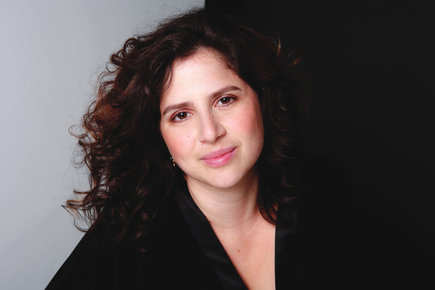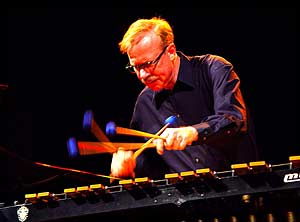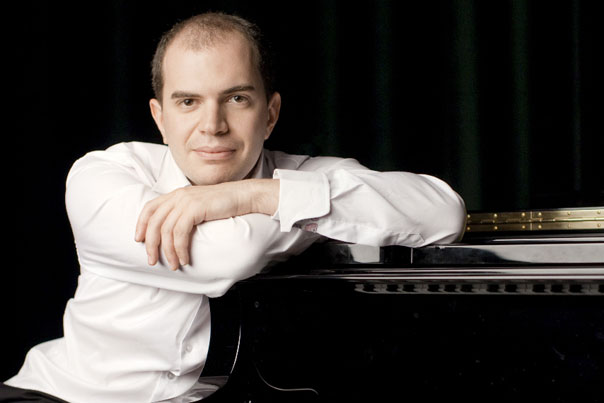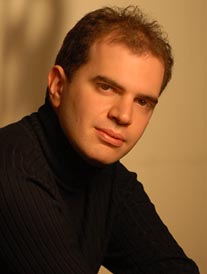Jazz Concert Review: An Evening with Kirill Gerstein at Berklee or, The Jazz Piano Concerto, Part 2.5
Like other great artists—Martha Argerich and Steve Lacy come to mind right away—pianist Kirill Gerstein approaches every note with a sense of how important that note is in relation to every one that has come before and every one that is to come after.
By Steve Elman
Regular readers of The Arts Fuse know that I’m engaged in writing a four-part series on the jazz piano concerto (Part One, Part Two). Fortuitously for me, smack between the “jazz half” and the “classical half” of the series, a deus ex machina descended to exemplify and amplify the issues I’ve been wrestling with. On Friday March 30, pianist Kirill Gerstein came to town for a conquering-hero triumph at the Berklee Performance Center that looked all of the jazz v. classical issues straight in the eye and came up with isn’t-it-obvious resolutions. A large crowd enthusiastically witnessed the visitation.
There isn’t space in this review for me to detail Gerstein’s rise from Russian piano wunderkind (sorry, I don’t know what the equivalent Russian words might be) to youngest-degree-student-ever-at-Berklee to first-rank classical artist. Fortunately, I don’t have to. Tony Tommasini’s review of Gerstein’s June 28, 2011 performance with the New York Philharmonic says everything that needs to be said about his skill as an interpreter and his current status as a Pianist to Hear.
The March 30 program was created by Gerstein as a sort of return to his jazz roots, but it was actually a meditation by a classically-focused artist on the potential riches of the jazz-classical conversation. Nearly every note played on stage had been written out beforehand, and yet nearly every note resonated with the century of jazz innovation that preceded the performance.
According to the program, the concert was being recorded by Myrios Classics for future release, so consider your coattails pulled.
The program itself was a model of balance: an opening set of four solo piano pieces, alternating between Györgi Ligeti’s etudes and Earl Wild’s concert studies on Gershwin themes; a set of Iberian-American pieces arranged by Oded Lev-Ari for a 16-member ensemble (minus Gerstein), spotlighting Anat Cohen’s superlative clarinet skills; a set of variations for piano solo by Brad Mehldau, commissioned by Gerstein; a duet for piano and vibraphone by Chick Corea, also commissioned by Gerstein, featuring Gary Burton; a true jazz duet by Gerstein and Burton on Oscar Levant’s “Blame It on My Youth”; and the 1924 jazz-band version of George Gershwin’s “Rhapsody in Blue,” conducted by Eugene Friesen.
I’m going to rearrange consideration of the Gerstein performances in keeping with my goals in this series—marching from the jazz end of the spectrum to the classical.

Anat Cohen — she has one of the most gorgeous sounds on clarinet that you can hear today. Photo: Bill Westmoreland
But first, a note on the Cohen/Lev-Ari collaborations, which really sit outside this spectrum: Multi-reedwoman Anat Cohen has one of the most gorgeous sounds on clarinet that you can hear today, and Gerstein wanted her to play the opening passage of “Rhapsody in Blue,” so he gave her a proper feature spot. She chose to play three short pieces drawn from her CD Noir (Anzic, 2007): “La Comparsa” by Cuban composer Ernesto Lecuona (1896–1963), “Ingenuo,” by Brazilian songwriter Pixinguinha [Alfredo de Rocha Vianna, Jr.] (1897–1973), and “Carnaval de São Vicente” by Pedro Rodrigues, which evoked music of the Cape Verdean islands. They’re among the most classically-oriented of the pieces on Cohen’s CD, with colorful and challenging arrangements by Oded Lev-Ari, who was on hand at Berklee to conduct an ensemble of faculty and students.
The selection of music was just broad enough to suggest the vast world of Latin-American/Brazilian song (with the understanding that Cape Verdean music has a relationship both to Brazilian and to Portuguese traditions). Cohen played the pieces idiomatically and with a bit of improvisation. She showed off a richness of timbre from the top to the bottom of the clarinet, a sound alive with wood, in the chewy tradition of Barney Bigard’s Creole licorice rather than the hard candy of the Benny Goodman/Jimmy Hamilton approach. The ensemble sounded under-rehearsed and a little ragged, missing the light touch and fluidity this music wants, but Eugene Friesen had a few moments to show off his arco and pizzicato cello work, and trumpeter Jame Cronin got a nice solo spot in the Rodrigues.
The jazziest of the Gerstein performances was an exquisite interpretation of Oscar Levant’s “Blame It on My Youth,” featuring Gary Burton. Burton is the Art Tatum of the vibraphone and a god at Berklee, but I never fail to hear him without thinking that somehow he is still under-appreciated. His self-effacing, Midwestern personality and his eagerness to direct the spotlight to his collaborators often leave his own musicianship in a kind of shadow.
Yet, as soon as he touches his instrument, the sound is so distinctive, the virtuosity so assured, that you wonder why he is not more famous, why he hasn’t made more recordings, why, as he approaches the age of 70, that he hasn’t yet been given a Kennedy Center Award or a Presidential Medal of Freedom. As an interpreter of popular song and a jazz improviser, Burton is a master of an unforgiving axe, melting the vibraphone’s metal into shadings and nuances that are utterly personal and utterly profound. Maybe, like Sonny Rollins and Ornette Coleman, he’s going to have to survive for another decade before people start calling him a Living National Treasure. Here’s how great his jazz performances are: it was only during “Blame It on My Youth” that one could completely forget that Gerstein was on stage.

Gary Burton — As an interpreter of popular song and a jazz improviser, he is a master of an unforgiving axe.
The other Gerstein-Burton duet, Chick Corea’s “The Visitors,” was a surprise in almost every way. In 2010 Gerstein won the $300,000 Gilmore Artist Award, one of the most prestigious honors a pianist can achieve. He promptly plowed some of his award money back into music, commissioning new works for his own performance, including through-composed pieces by artists known primarily for their jazz abilities, Chick Corea and Brad Mehldau. Both of these pieces received world premiere performances in this evening at Berklee, and Corea’s “The Visitors” showed just how fast the composer is progressing on the other side of the jazz-classical divide. This is a searching, emotionally rich piece of music that reaches depths of feeling Corea has only brushed in his concerti (for more on them, see my previous posts in this series).
In addition, Corea showed singular generosity in writing for a combination that he virtually owns and then giving the piano part to someone else. Of Burton’s six Grammys, five of them have been awarded for collaborations with Corea. Over more than three decades of performing together, these two musicians have learned to phrase identically and, especially in duet performances, to fuse their personalities into something that is much more than a sum of the parts. Inevitably, no other pianist could be as closely tuned to Burton as is Corea, but Gerstein’s performance was fascinating because it was so different from what Corea might have done with the music.
This is as good a place as any to talk about Gerstein’s gift of phrasing. Like other great artists—Martha Argerich and Steve Lacy come to mind right away—Gerstein approaches every note with a sense of how important that note is in relation to every one that has come before and every one that is to come after. This is not just a matter of microseconds around the note or of tiny shifts in volume to emphasize or deemphasize; it’s a matter of bringing individual moments together into a unified experience, of making sure that the thought-line of the music is continuous and coherent while giving each phrase the loving care it deserves. He took every note that Corea presented to him as seriously as he might have taken something given to him by Beethoven, and that approach gave the performance a weight and gravity that was deeply satisfying.
Even so, the unison lines for vibes and piano were not quite perfect. This may be because of the inherently different approaches by jazz and classical musicians to the first beat of every bar. Jazz players often achieve a balance in performance by delaying the feel of the “one” ever so slightly—the music already has plenty of forward propulsion, and a relaxed approach to the first beat is one way to keep the performance flexible, to let it swing. Classical players are working with notes on a page, which can be static or monotonous if played exactly as written, so they often give their interpretations edge and drive by gently anticipating the “one.” These two approaches led to some blurriness in passages that were written to be played exactly together.
I assume that Gerstein could have played the unisons in Corea’s piece precisely as Burton did, and that he made a choice to phrase differently, possibly to highlight that there was a real dialogue going on. In any case, the result was something rather different from Corea’s recordings with Burton, a tautness that increased as the players came to an ostinato section where Burton had the chance to improvise. The resulting solo was like the flight of a raptor released from its keeper’s arm into the air, majestic and unfettered, finally coming back to earth to join the written material and give the whole piece a sense of completeness.
The other world premiere, Brad Mehldau’s “Variations on a Melancholy Theme,” suffered a bit by comparison. If this had been a solo piano improvisation by Mehldau or Keith Jarrett, listeners would have marveled at the inventiveness and fertility of the ideas—a kaleidoscope of successive transformations of a brief theme that held kernels of sad pop tune and blues. But knowing that it had been composed in almost every detail made it seem a little prolix, as if the composer should have given more consideration to preserving only those phrases that were absolutely necessary.
The ghost of Gershwin hovered over the whole program, from the Wild studies to Lecuona’s music (he’s still sometimes called “the Cuban Gershwin”) to the song by Levant (who was one of Gershwin’s friends and consummate interpreters), and in some ways, everything else was overshadowed by “Rhapsody in Blue.”
This work is so familiar that most of us can’t remember when we first heard it, and many of us know it so well that we can play it back in our heads any time we want to. I’ll have more to say about it in the next part of this series, but for now it’s worth noting that what was a novelty item in its day (1924) has now become a genuine American classic that preserves a distinctive moment in our music, when jazz was still young and brash and when a composer of songs could wow the folks in tuxes with sophisticated syncopation. When you hear Oscar Levant play it in the 1945 recording with the Philadelphia Orchestra, you get as close to those heady days as may be possible without a time machine.
But Gerstein’s performance, even though it was placed in the context of Ferde Grofé’s original “jazz band” orchestration as played by the Paul Whiteman Orchestra, was informed by many subsequent decades of jazz. In nearly every passage given to the piano, he added grace notes and tiny trills, re-formulated rhythms, changed the attacks, softened some of the brittle 20s feel into more modern swing, and in doing so refreshed the familiar moments marvelously.
Emcee and co-producer Phil Wilson, dapper and genial, noted in his introduction that the Berklee faculty and students had worked for months on the score, and the care showed. Each of the tiny solo spots was perfect—Anat Cohen’s clarinet intro was soulful and a bit Klezmeric, just as it should have been; Charlie Lewis’s plunger-muted trumpet, Daniel Ian Smith’s baritone duet with Cohen, the violin duet, the horn statements, the braying trombones . . . all very idiomatic, even if a bit at odds with Gerstein’s gentle exertions to get the music out of the 20s. Eugene Friesen conducted the proceedings with a sure hand.
In this piece and in Cohen’s features, the Berklee sound crew did an admirable job making sure that every detail could be heard without a hint of distortion. Regrettably, the Performance Center’s acoustics are nowhere near comparable to those of Jordan Hall, so we missed the beautiful blend of sound that a great space could provide, but even so, the “Rhapsody” was a thrilling and powerful conclusion to the evening.

Pianist Kirill Gerstein — he has successfully slain the dragon of Prodigy and moved on to much bigger monsters.
But it began with something almost as thrilling, though on a much smaller scale, and almost purely classical in concept—four brief piano pieces knitted into a suite by Gerstein. It takes big ears to hear how etudes by Györgi Ligeti could mesh with concert studies by Earl Wild, but Gerstein has those ears. He made an outstanding case for each piece and for his own inspiration of putting them together as a curtain-raiser. Ligeti’s fourth etude (“Fanfares”) uses a 7/8 ostinato that passes back and forth between the hands, and even though Ligeti said that the piece was inspired by music of sub-Saharan Africa, the melodic material occasionally sounds like it’s going to slip into Zez Confrey’s “Kitten on the Keys.” Gerstein brought out the off-kilter boogie-woogie in the concept and captured the crowd’s ears immediately. After the briefest pause, he launched into Wild’s concert study on Gershwin’s “Somebody Loves Me,” with a figure in the first few bars that seemed lifted directly from the Ligeti. Wild’s smoky and noirish reharmonizations of Gershwin’s tune gave us a couple of moments that prefigured Ran Blake, and then Gerstein seamlessly blended the conclusion of that piece into the beginning of Ligeti’s fifth etude, highlighting a passage that made Ligeti sound like he was paying Wild back.
The set concluded with Wild’s study on “I Got Rhythm,” richly polyphonic and tremendously challenging. If anyone had any doubts about Gerstein’s ability and commitment, those short pieces said it clearly: the man is here to play.
(New England All Classical’s Cathy Fuller interviewed Gerstein a few days before the concert, and he played the Wild concert studies and one of the Ligeti etudes in the WGBH studio. It’s available to hear on demand.)
I haven’t yet mentioned that Gerstein turns 33 this year, and I did so intentionally. His early start in music is simply not important anymore; he has successfully slain the dragon of Prodigy and moved on to much bigger monsters. What is significant now about his time on earth is that we have so much more of it to enjoy.
Recordings discussed above
Anat Cohen: Noir (Anzic CD, 2007)
Gary Burton and Chick Corea: Duet (ECM LP, 1978) [Grammy award, 1979]
Chick Corea and Gary Burton: In Concert, Zürich, October 28, 1979 (ECM LP, 1980) [Grammy award, 1982]
Chick Corea and Gary Burton: “Rhumbata” from Native Sense: The New Duets (Stretch CD, 1997) [Grammy award, 1998]
Gary Burton (with Chick Corea, Pat Metheny, Roy Haynes, Dave Holland): Like Minds (Concord CD, 1998) [Grammy award, 2000]
Chick Corea and Gary Burton: The New Crystal Silence (Concord CD, 2008) [Grammy award, 2009]
George Gershwin: Rhapsody in Blue (1924) — Oscar Levant, p; Philadelphia Orchestra; Eugene Ormandy, cond [Rec. 1945; originally issued in 78 rpm set; reissued in Levant Plays Gershwin, CBS CD, 1987]
Tagged: Anat Cohen, Berklee Performance Center, Brad Mehldau, Chick Corea, Gary Burton, Gilmore Artist Award, jazz piano concerto


